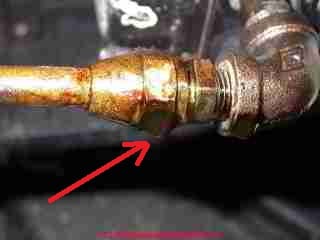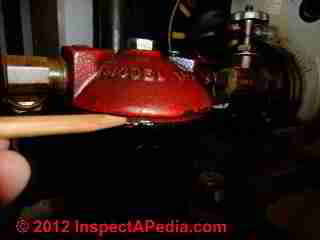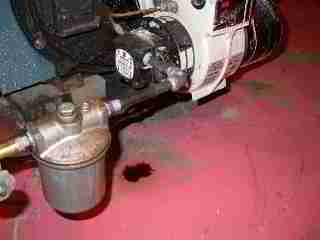 Oil Filter Leak Points on Oil-Fired Heating Equipment
Oil Filter Leak Points on Oil-Fired Heating Equipment
- POST a QUESTION or COMMENT about installing, servicing, and repairing oil filters used on oil-fired heating equipment & water heaters
Oil burner filter leak diagnosis & repairs:
We discuss tracking down air and oil leaks at or near the oil filter canister and we describe proper oil filter location and problems to check for during oil filter cartridge changes.
We include considerations of oil pipe leaks out (fuel oil leaks), oil piping leaks in (air in the system), clogged, damaged, noisy, or mis-routed fuel oil piping, and oil fill and vent piping size and location requirements. We also discuss the need for and location for heating oil or fuel oil filters and safety valves.
InspectAPedia tolerates no conflicts of interest. We have no relationship with advertisers, products, or services discussed at this website.
- Daniel Friedman, Publisher/Editor/Author - See WHO ARE WE?
Common Heating Oil Leak Points at the Heating Oil Filter
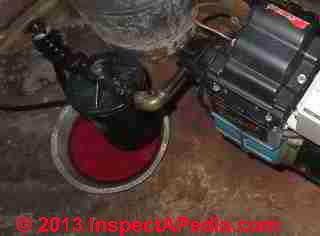 at OIL FILTERS on HEATING EQUIPMENT we described changing the oil filter as part of oil burner maintenance. And there we warned about leaks in piping fittings at the burner and at the oil filter canister assembly. Here are the details.
at OIL FILTERS on HEATING EQUIPMENT we described changing the oil filter as part of oil burner maintenance. And there we warned about leaks in piping fittings at the burner and at the oil filter canister assembly. Here are the details.
Our photo at left shows a pretty severe oil line leak that seems to be coming from the oil safety valve just ahead of the oil filter. We discuss this leak in detail
at OIL SUPPLY LINE PIPING LEAKS.
[Click to enlarge any image]
At below left we illustrate a dripping heating oil leak below the connection to the filter outlet? This leak will suck air into the oil burner when it's running, leading to improper and possibly unsafe operation, risking a puffback.
After any service procedure that disturbs oil line, filter, or burner oil piping fittings we recommend checking for evidence of oil leaks again after the system has been in use for a day or so, because slow leaks and small leaks in the oil piping system may not show up immediately.
Oil piping leak at the copper piping flare to iron piping connection.
As we explained earlier, oil leaks anywhere in the oil piping and filter system may be hazardous.
That's because even though the absolute amount of oil that drips out may be trivial, an oil leak out is an air leak in to the oil piping system as well.
Air may be drawn into the oil line when the fuel unit is pumping leading to improper oil burner operation, a dangerous puff-back, or loss of heat in the building.
Where Do We Usually Find Leaks at the Heating Oil Filter Canister Assembly?
Here are more illustrations of places where we often find leaks at heating oil filters: at the canister air bleed screw (not tightened, stripped threads, or failure to install a fresh gasket), at the canister top center bolt (same), and at the joint between the oil filter canister lid and base.
The oil filter assembly shown in the photos below was in deed leaking.
But it took a bit of work to find out exactly where the problem was. Because oil flows from a leak anywhere on the canister top down the canister sides, you can be fooled about exactly where the heating oil leak is occurring. That's why an expert cleans and dries all of the surfaces meticulously.
That makes watching for leaks easy.
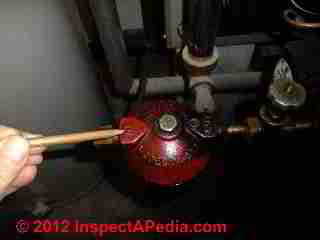
We examined the connections at the inlet side of the oil canister, the flare itself and the IPT threaded fitting entering the canister lid (above).
Note: that Fire-o-Matic fusible link oil line valve was installed in the wrong place: it's shown between the oil filter and the oil burner - at the outlet end of the oil filter canister. It should have been installed on the inlet end of the oil filter canister (where my pencil points) so that we can shut off oil into the canister in order to open it and to change the filter.
Next we examined the filter mounting bolt at the center of the canister lid (below).
Other tricks for finding an oil leak include using tracer powders on the cleaned surface, pressure tests, and even a paper towel on the floor below suspected drip points.
Next we examined the air bleed screw (below) - ultimately we found both the center top bolt loose and the air bleed screw loose - the heating service tech had just forgotten to check & tighten them.
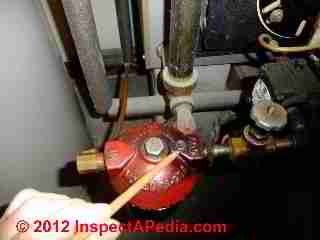
Just below I indicate where you will often find wet heating oil - in the gap between the canister lid and canister base. But this is a confusing "wet oil" location.
It could be wet in this spot for the following reasons:
- The service tech did not adequately wipe everything clean after s/he installed the new oil canister. This is especially true if air is bled from the small bleeder screw (above left) allowing oil to run over the top of the assembly where it enters the gap at above right.
- There is a leak at any point high on the oil canister assembly lid, including heating oil leaks at all three of the leak points in our first photo: the filter canister input side threaded fitting, the center mounting bolt, or the air bleeder screw.
- There is a bad gasket (old, nicked, broken, too small, or even forgotten) between the oil filter canister lid and canister base
- The oil canister mounting center bolt was left too loose..
Where & Why Leaks Occur at Heating Oil Filters - & How to Fix Heating Oil Filter Leaks
 Watch out: leaks in heating oil appliance piping or filters can be much more serious than just a drip spot on the floor.
Watch out: leaks in heating oil appliance piping or filters can be much more serious than just a drip spot on the floor.
The same leak that allows oil to drip out of the oil filter or piping connections allows air to be drawn into the system when the oil fuel unit (oil pump for the water heater, oil fired boiler or furnace) is running.
That air leak into the system results in improper oil burner operation, soot clogging, and even a loud bang at oil burner start-up or worse, a dangerous puffback. Detailed explanation of why an oil line leak causes a bang or puffback at the oil burner, and loss of heat is
at OIL LINE LEAKS - Oil Line leaks found
Reader Question: Why is my oil filter canister leaking oil - apparently from the bottom of the unit?
I recently replaced my oil filter (I actually replaced the entire oil canister with a new oil canister that included the filter already inside of it). The burner is working properly, the flame is on,and I'm getting hot water.
The problem is that I seem to have a small/minor leak from the oil canister itself. Oil is dripping from the canister (I think it's leaking from the bottom of the canister). I've checked all the fittings to make sure they're not loose.
They're all tight, as are all the connections in and out of the oil canister.
Do you know why the oil canister could be leaking? Was I supposed to tighten the bolt/screw that's on the bottom of the canister (underneath the filter) as well? I assumed the oil canister came ready to install and that I wouldn't have to adjust the top or bottom bolts on the canister.
Any idea why the oil canister is leaking oil (from the bottom)? - Thanks, Ed Salva
Thanks to Mr. Salva for the Mitco oil filter canister photo (above left). Mr. Salva's photo illustrates an important detail: place a suitable container below the oil filter canister to catch any spills before you attempt to service the unit.
Reply: Check for missing or damaged fiber washers and o-ring as well as leaky flare fittings
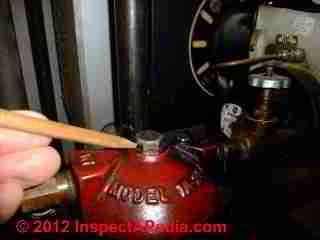 Ed,
The oil filter canister does not normally leak through its bottom as that is solid steel on the models I am familiar with. Only an older canister with rust perforation would leak there.
Ed,
The oil filter canister does not normally leak through its bottom as that is solid steel on the models I am familiar with. Only an older canister with rust perforation would leak there.
The oil filter canister is installed with a bolt that goes down through the red top and taps into threads in the bottom of the canister.
In our photo (left) my pencil points to the top bolt that secures the oil filter canister base to the top.
There are two seals: a (usually red) fiber washer that mounts under the bolt head and an O-ring seal between the lip of the canister and its top.
There is also a tiny fiber washer underneath a small air bleeder screw found on the top of the oil filter canister.
Just below you can see a closeup of this oil filter air bleed outlet on another oil filter canister brand, and there you'll see the fiber washer too.
If any of those three seals were omitted or damaged, that would make an oil leak that might begin at the edges of the canister or even its top but then run down the device and appear to be dripping off its bottom.
Tightening the bolt won't fix a missing or damaged gasket or seal.
Also see OIL BURNER FUEL UNIT AIR BLEED PROCEDURE
Where to leaks occur at heating oil filter canister assemblies?
Another common leak point at oil filter cartridges is the joint between the oil filter canister base and the red oil filter assembly top. If a hasty service tech (or you) forgot to tighten the top bolt the result will be an oil leak and improper oil burner operation. Common leak points at or close to a heating oil filter assembly include:
Leaks between the canister base top edge and the canister top, due to an old, faulty, gasket or due to a loose assembly top bolt
Leaks at the oil filter air bleeder screw due to a faulty or missing gasket or due to a loose bleeder screw
Leaks at the oil filter fittings entering and leaving the canister assembly, particularly at flare fittings that may have been wiggled and jiggled around by a heavy-handed service person who used just one wrench to loosen or tighten the top bolt. Use two wrenches, one on the bolt and one on the rectangular inlet or outlet casting to avoid twisting oil piping and causing still more oil piping leaks.
If you never have opened the oil filter canister, I'd shut off oil at the fire-o-matic valve between canister and oil tank, turn off the oil burner of course, and open the canister - to be sure it contains a filter and to be sure that all of the gaskets and o-rings are in place and un-damaged.
At OIL TANK PIPING & PIPING DEFECTS you'll find more about oil piping and filter leaks, photos, and suggestions.
In the article OIL FILTERS on HEATING EQUIPMENT you will see photos of the filter canister type I'm discussing.
Send me a photo of your filter/canister as it may be a different brand or model than what I describe above.
Continued from Ed:
Thanks for the quick response. I have to say that this website has a TON of valuable information!
I'm at work now but when I get home I'll try to attach a picture of the oil filter. It actually looks very similar to the one in the picture on this website (the picture under "HEATING OIL FILTER - NONE - No Oil Filter Installed on Oil Fired Equipment"). The silver one.
I replace the filter yearly on my burner. This year, I decided to change the whole canister as I felt it needed to be changed (it's the original canister that was installed 8 years ago). Then I ran into the problem of oil leaking from the oil canister.
When I first replaced the oil canister a couple of days ago, that's when I noticed the oil leak. I thought immediately that I had bought a defective oil canister. So I decided to take it apart. Surprisingly, everything in the canister was intact (filter, o-ring, etc).
Then I went back to the hardware store and purchased ANOTHER oil canister and installed this new one. Same problem, oil leak from bottom of oil canister.
That's when I started researching and came across this site and posted my question.
Can the nozzle have anything to do with this leak? It's not a major leak, just a few ounces per day. Nonetheless, any oil leak is not good and I want to stop the leakage if I can on my own.
When I got home last night, I took some pictures of the oil canister.
I don't know how to attach photos to the comments section here, thus I can email them if interested.
I also noticed that the small leaks seems to be coming from the 'OUT' part of the oil canister. I checked to make sure the fitting was tight, and it was. I will take the brass fittings off and put on pipe joint compound on the pipe threads. Then I'll reattach the brass fittings to the oil canister/pipes and make sure that the lines are air tight. Hopefully, this will stop the leak.
I don't want to make them to tight where I risk stripping the threads or the brass fittings.
Continued from DF:
Ed mail photos using the CONTACT link found at top, left, or bottom of our web article pages.
Try using blue LeakLok™ thread sealing compound (available at auto supply stores, plumbing and heating suppliers, or from Argo [1]) on thoroughly cleaned threads at the outlet fitting on your canister. I'd clean the reads carefully on both mating surfaces and then use that product or a similar one rated for use on piping systems for heating oil.
I agree with taking care not to strip threads. Using a sealant can help avoid trying to fix a leak just by tightening. Also FYI iron pipe threaded fittings are tapered so that the fitting gets tighter as it is turned inwards.
But that means that every time you disassemble and re-use a fitting it has to be turned in further than before to get tight. In turn that means on some devices a fitting can bottom out or reach end of threads without being satisfactorily tight.
That's why plumbers often will not re-use brass-to-steel fittings such as the adapter on your filter canister inlet and outlet sides. If you disassemble and reassemble, it's cheap to use a new fitting plus leak-lok.
Beware: an oil leak OUT is also an air leak IN under varying operating conditions and an air-leak in causes burner operating problems, sooting, and even risks a puffback.
Tips for the Follow-Up Check for Oil Leaks at the Heating Oil Filter
 After heating oil burner service of any sort we recommend checking for evidence of oil leaks again after the system has been in use for a day or so. Slow leaks and small leaks in the oil piping system may not show up immediately.
After heating oil burner service of any sort we recommend checking for evidence of oil leaks again after the system has been in use for a day or so. Slow leaks and small leaks in the oil piping system may not show up immediately.
Clean the floor beneath and around the heating oil filter and oil piping. Check back in a day or two for fresh heating oil spots on the floor (below left).
If you leave a clean paper towel below the oil filter and connectors it can make spotting an oil drip easier.
Also remain alert for signs of oil burner operating problems like new or unusual noises, sooting, or smoky operation.
See details at OIL BURNER NOISE SMOKE ODORS
While there is a variety of causes of improper oil burner operation, leaks in the oil piping are among them.
Fix any oil leaks immediately. An air leak into the oil piping system leads to improper oil burner operation, risking a dangerous puff-back, or loss of heat in the building.
This Q&A were posted originally
...
Reader Comments, Questions & Answers About The Article Above
Below you will find questions and answers previously posted on this page at its page bottom reader comment box.
Reader Q&A - also see RECOMMENDED ARTICLES & FAQs
On 2020-03-31 - by Matt Cope - I have a little leak at my heating system's oil filter
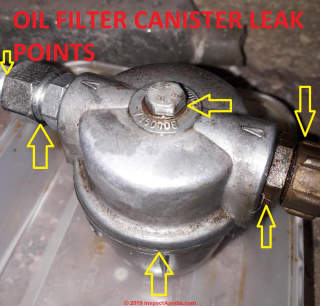 Good afternoon, firstly, i hope you and your friends and family are well?? Attached is a filter we have which I'm hoping you can see clearly.
Good afternoon, firstly, i hope you and your friends and family are well?? Attached is a filter we have which I'm hoping you can see clearly.
I recently had an engineer come out to fix the boiler which wasnt firing up. One thing he did was check the filters for me and since then
I have a little leak. Do I need to simply tighten the nut up? Replace the o rings or just get the engineer out again? Thank you in advance
This Q&A were posted originally
[Annotations on photo are by InspectApedia.com - Ed.]
[Click to enlarge any image]
Moderator reply: Where is the oil leak at our oil filter?
Matt:
RE: Where is the oil leak at our oil filter?
There are several places that may leak around the oil filter canister, especially following service that included changing the oil filter. I'll list them below.
Start by wiping the entire outside surfaces of the whole assembly including my points below - totally clean and dry of oil.
Then inspect: you may be able to find the by checking again with a clean dry finger (don't touch your face) every day or so for a few days.
You an also gently tighten every fitting at and around the oil filter. Take care not to over-tighten so as to damage the threads or crack a flare fitting.
Watch out: leaks out at an oil filter or anywhere in the oil piping system can mean air leaks into the system too when the fuel unit is running. Air leaks can mean improper burner operation, sooty flame, and ultimately a puffback explosion. So yes, find and fix the leak.
Recap of Common Leak points at Heating Oil Filters
1. Oil line connections at or near the oil filter: oil line in, oil line out, nearby OSV (Oil Safety Valve or Fire-o-Matic valve) fittings
2. Oil canister center mounting bolt. There should be a small gasket under the bolt head between bolt and canister top. Usually that's replaced when the filter is replaced. A bolt that's not loose or a missing gasket will leak.
3. Oil canister air bleeder screw: a small screw found at the outlet end of the oil canister cap on some models (yours doesn't show this screw)
4. Oil filter canister gasket: a large flat rubber gasket between the oil filter canister top and base, usually replaced when the oil filter is changed. A missing, damaged gasket or an inadquately-tightened center bolt may cause leaks around the mating surface of the canister top and base.
Other leaks are discussed in the article above on this page
On 2017-01-22 - by (mod) - Leaks at the oil filter of an oil burner risk air leaks
Linda
Leaks at the oil filter of an oil burner risk air leaks into the system too when the oil pump (fuel unit) is running - ie when the burner is on.
IN turn that can cause sloppy oil burner start-up or shut-down flame conditions that can in turn lead to improper burner operation, loss of heat, or in extreme cases an OIL BURNER PUFFBACK that can be dangerous as well as messy.
Search InspectApedia.com for (or click on) PUFFBACKS, OIL BURNER
Yes the tech needs to find and fix the air leaks and she may need to bleed air from the system.
On 2017-01-20 2 by Linda in RI - noisy smoky oil burner
Never had oil heat before buying my first house 3 years ago. It is mostly steam radiators but there are baseboards in one section of the house. Up until recently everything was fine. I had my annual maintenance (tune up) done on my oil burner on 11/1/16.
The technician did his thing, updated the tag on the machine, and provided me with a list of what was done. I filed it away. Noticed that the filter near the oil tank seemed a bit grimy. Cleaned it off and rechecked. It was oily.
Also noticed my burner seemed much nosier than usual...really loud noises at startup. Rooms with the baseboards seemed much colder than they should. I even put a thermometer in oneto see what the temp was....brrr.
I also burned through a tank of oil in less than six weeks - despite above average temp's in the northeast (RI) and not using that much in prior years. I googled the web and found your site. I looked at some of the items that were replaced during maintenance: 15ox80B, general filter, mini strainer.
I think the tech totally screwed up and caused the filter leak issue... in fact the filter looks a bit skewed ....not straight like before. I called the company and they are coming in a few days.... no charge supposedly. I will be watching him to see what he does.
Do I need to ask them to bleed the pipes...if oil is getting out then the air is getting in ....at least that is what I read in the article. Are the loud noises from the air or is it possible he also "screwed up"(technical term) replacing the nozzle....
What do I need to watch for...or what questions should I ask? Could this ruin my boiler (which is less than 5 years old).
On 2015-11-27 - by (mod) -
I'm glad that worked for you as a stopgap measure for you, Tom. If the screw is an sir bleeder valve it will need to be removed at each filter change. Usually oil filters include replacement gaskets. Just take care not to strip the screw.
On 2015-11-26 by Tom A
Nevermind, I used the "hammer" feature on my cordless drill and it tigtened the screw about 1/8 - 1/4 turn which was enough to stop the drip! Hurray. Thanks for your quick response, willingness to help further and the wealth of knowledge already on this site. Much appreciated. Happy Thanksgiving!
On 2015-11-26 - by (mod) -
Please use the page bottom CONTACT link to send me photos of the side, top, and any markings on your oil filter and I can comment better.
I suspect you need to replace the gasket in question.
On 2015-11-26 1 by Tom A
Hello,
My filter head looks different than those in your photos. It has a large center bolt on top of the filter head but then on top of that bolt there is a screw with gasket that screws into the top of the bolt. I have a very slow drip from that screw. There is a gasket under the screw and I checked and the screw is tightened. If I loosen it starts dripping faster. Any suggestions?
...
Continue reading at OIL FILTER CHANGE STEPS or select a topic from the closely-related articles below, or see the complete ARTICLE INDEX.
Or see these
Recommended Articles
- OIL BURNER FUEL UNIT AIR BLEED PROCEDURE
- OIL BURNER NOISE SMOKE ODORS
- OIL FILTERS on HEATING EQUIPMENT
- OIL TANK PIPING & PIPING DEFECTS
- OIL TANK SPILL CLEANUP / PREVENTION
- PUFFBACKS, OIL BURNER
Suggested citation for this web page
OIL FILTER LEAK POINTS at InspectApedia.com - online encyclopedia of building & environmental inspection, testing, diagnosis, repair, & problem prevention advice.
Or see this
INDEX to RELATED ARTICLES: ARTICLE INDEX to HEATING OIL, OIL BURNERS, OIL FIRED HEATERS, OIL TANKS
Or use the SEARCH BOX found below to Ask a Question or Search InspectApedia
Ask a Question or Search InspectApedia
Try the search box just below, or if you prefer, post a question or comment in the Comments box below and we will respond promptly.
Search the InspectApedia website
Note: appearance of your Comment below may be delayed: if your comment contains an image, photograph, web link, or text that looks to the software as if it might be a web link, your posting will appear after it has been approved by a moderator. Apologies for the delay.
Only one image can be added per comment but you can post as many comments, and therefore images, as you like.
You will not receive a notification when a response to your question has been posted.
Please bookmark this page to make it easy for you to check back for our response.
IF above you see "Comment Form is loading comments..." then COMMENT BOX - countable.ca / bawkbox.com IS NOT WORKING.
In any case you are welcome to send an email directly to us at InspectApedia.com at editor@inspectApedia.com
We'll reply to you directly. Please help us help you by noting, in your email, the URL of the InspectApedia page where you wanted to comment.
Citations & References
In addition to any citations in the article above, a full list is available on request.
- Audels Oil Burner Guide, Installation, Servicing, Repairing, Frank D. Graham, 1940's edition (obsolete). Updated versions of this guide are available in various editions, 1947, 1950, 1955, 1958, 1959, 1962, 1965, 1967, and at prices from around $3.00 to nearly $70.00 - useful for simple, clear, but not current, explanation of how heating equipment works. The original retail price was $1.00.
- [1] LeakLok™ blue thread sealant compound is available from Argo, Inc., 2610 Commerce Way, Vista CA 92083, tel: 800-854-1015. Quoting from the company's product literature:
Leak Lock Blue Joint Sealing Compound 1.3 oz. tube Soft setting joint compound that seals threaded joints, gasket surfaces and mating surfaces. Resin-based brushable paste which remains permanently flexible, internal surfaces and fills voids. Excellent for use on metal and plastic materials subject to extreme vibrations. - Our recommended books about building & mechanical systems design, inspection, problem diagnosis, and repair, and about indoor environment and IAQ testing, diagnosis, and cleanup are at the InspectAPedia Bookstore. Also see our Book Reviews - InspectAPedia.
- In addition to citations & references found in this article, see the research citations given at the end of the related articles found at our suggested
CONTINUE READING or RECOMMENDED ARTICLES.
- Carson, Dunlop & Associates Ltd., 120 Carlton Street Suite 407, Toronto ON M5A 4K2. Tel: (416) 964-9415 1-800-268-7070 Email: info@carsondunlop.com. Alan Carson is a past president of ASHI, the American Society of Home Inspectors.
Thanks to Alan Carson and Bob Dunlop, for permission for InspectAPedia to use text excerpts from The HOME REFERENCE BOOK - the Encyclopedia of Homes and to use illustrations from The ILLUSTRATED HOME .
Carson Dunlop Associates provides extensive home inspection education and report writing material. In gratitude we provide links to tsome Carson Dunlop Associates products and services.


